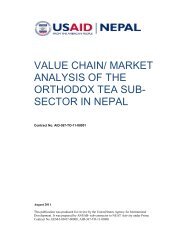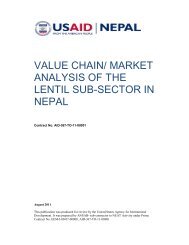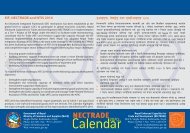value chain/ market analysis of the ginger sub-sector ... - Nepal Trade
value chain/ market analysis of the ginger sub-sector ... - Nepal Trade
value chain/ market analysis of the ginger sub-sector ... - Nepal Trade
- No tags were found...
You also want an ePaper? Increase the reach of your titles
YUMPU automatically turns print PDFs into web optimized ePapers that Google loves.
Due to <strong>the</strong> aggressive seasonal migration <strong>of</strong> laborers to overseas work, non-family memberlaborers are becoming less prevalent every day.Transportation cost: Transportation costs include transportation <strong>of</strong> <strong>the</strong> product to local<strong>market</strong>s or up to road-heads where traders are located.Land renting cost: Normally, farmers cultivate <strong>ginger</strong> on <strong>the</strong>ir own land. If <strong>the</strong>y have to rent<strong>the</strong> land, <strong>the</strong> cost will vary. The average land renting cost estimated is around 20,000NPR/hectare and is included in <strong>the</strong> production costs.2.3 Distribution <strong>of</strong> Value AdditionFresh <strong>ginger</strong> is <strong>the</strong> most traded product and is harvested during both <strong>the</strong> main season and<strong>of</strong>fseason (mo<strong>the</strong>r rhizome). Young <strong>ginger</strong> has a mild flavor and a pale, thin skin thatrequires no peeling. Fresh rhizomes with low fibre content but rich in aroma, pungency, fat,and protein are preferred from consumers.Fresh <strong>ginger</strong> does not go through very many <strong>value</strong> addition activities. The two most prevalentactivities include cleaning and sorting after <strong>the</strong> harvest. Cleaning begins at <strong>the</strong> farmer levelwhere only preliminary cleaning is completed by removing soil and roots from rhizome. Dueto a lack <strong>of</strong> awareness and incentives received for high quality products, farmers do notengage in a grading system. There is a practice <strong>of</strong> deducting 2 to 8 kg per sack (normally 50kg/sack) from farmers by <strong>the</strong> local traders depending upon <strong>the</strong> soil content in <strong>the</strong> product.Major cleaning is usually done at <strong>the</strong> traders level prior to exporting or sending it to <strong>the</strong><strong>market</strong>. However, during this study, we did not observe cleaning completed bytraders/exporters prior to exporting to India. Poor cleaning practices have resulted in a lowquantity <strong>of</strong> produce supplied by exporters and <strong>the</strong> Indian importers have been complainingabout weight loss and <strong>the</strong> soil content in packages. Fresh <strong>ginger</strong> from <strong>the</strong> eastern region iswashed in facilities at Naxalbari, <strong>the</strong> nearest Indian town on <strong>the</strong> Kakarbhitta border. Suchwashing facilities are owned by Indian traders as well as <strong>Nepal</strong>i traders and employ asignificant number <strong>of</strong> women as laborers. No such washing practice was found on <strong>the</strong>western border. One <strong>of</strong> <strong>the</strong> traders in Bhairahawa said that washing decreases <strong>the</strong> self-life <strong>of</strong>fresh <strong>ginger</strong> which is why <strong>the</strong>y choose not to wash. In Naxalbari, <strong>the</strong> cleaning process iscompleted in various steps which includes washing by placing in big pits, spreading in openareas, drying by air circulation, and placing in fresh jute sacks.During this study, increases in <strong>the</strong> price <strong>of</strong> <strong>ginger</strong> and <strong>value</strong> addition activities were noted in<strong>the</strong> eastern region. It was found that <strong>the</strong> level <strong>of</strong> <strong>value</strong> addition for fresh <strong>ginger</strong> is founddifferent in different places. Besides <strong>the</strong> way <strong>of</strong> processing <strong>of</strong> <strong>ginger</strong>, <strong>the</strong> taxes, customclearance and transportation also varied depending on geographic locations.2.3.1 Costs <strong>of</strong> Goods from Ilam to Naxalbari, IndiaTable 4 represents <strong>the</strong> distribution <strong>of</strong> <strong>value</strong> addition for fresh <strong>ginger</strong> from <strong>the</strong> productionareas <strong>of</strong> Ilam to Naxalbari where it is mostly handed over to washing facilities.Value Chain/Market Analysis-Ginger 9






